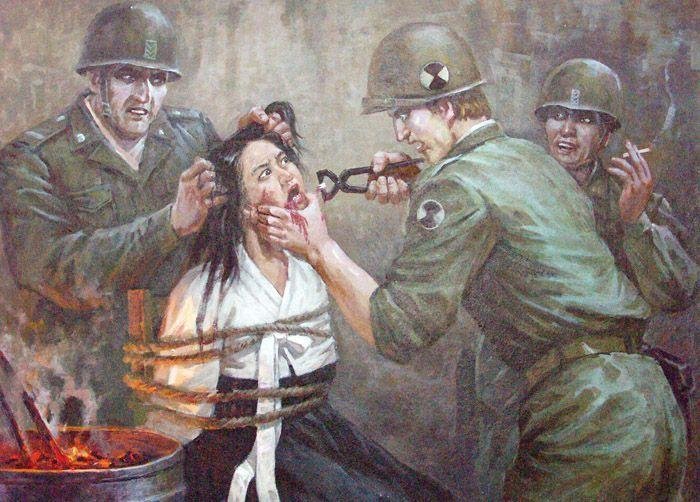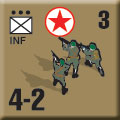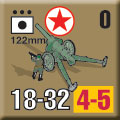| Pusan Perimeter:
Scenario Preview, Part Three
By Mike Bennighof, Ph.D.
October 2021
 The best part of any Panzer Grenadier game is the scenario set. Here’s a look at 10 moreKorean War: Pusan Perimeterscenarios. You can see the rest of the scenario previews in Part One, Part Two, Part Four and Part Five. The best part of any Panzer Grenadier game is the scenario set. Here’s a look at 10 moreKorean War: Pusan Perimeterscenarios. You can see the rest of the scenario previews in Part One, Part Two, Part Four and Part Five.
Scenario Nineteen
Convoy South
9 July 1950
North Korean front-line formations showed a great deal of discipline and planning when actually in contact with the enemy. When advancing against token opposition or none at all, they could become surprisingly careless. Near Chinch’on, one of the NKPA 2nd Division’s columns ran into an ambush set by the Capital Division and some South Korean police.
Conclusion
A successful ROK ambush netted four artillery pieces and 27 vehicles captured, temporarily blunting the North Korean advance. A three-day battle for the Chinch’on and Chonui areas began, eventually resulting in a South Korean withdrawal. The arrival of American supplies improved the ROK Army’s capacity to fight, while just the presence of American ground forces – the ROKs were as yet unaware of their poor performance – greatly boosted their will.
Notes
An ambush scenario: the Norks have to travel the length of two boards, and somewhere on there the ROKs are lurking, waiting for them. We’ve done ambush scenarios before in Panzer Grenadier, but they’re a little unusual. This one really should use the Hidden Units rule, a favorite of designer Jay Townsend.
Scenario Twenty
South of Chonui
10 July 1950
 With more of his division arriving. Maj. Gen. Dean ordered his troops to establish a series of blocking positions from which “maximum repeat maximum delay will be effected.” The 24th Infantry Division was responsible for covering the left flank of ROK units fighting hard around Ch’ongju, and Dean did not intend for another collapse to embarrass his division. Placing the remainder of the shaky 21st Infantry Regiment into line, he reinforced it with tanks, engineers and heavy artillery in hopes of stiffening their resolve. With more of his division arriving. Maj. Gen. Dean ordered his troops to establish a series of blocking positions from which “maximum repeat maximum delay will be effected.” The 24th Infantry Division was responsible for covering the left flank of ROK units fighting hard around Ch’ongju, and Dean did not intend for another collapse to embarrass his division. Placing the remainder of the shaky 21st Infantry Regiment into line, he reinforced it with tanks, engineers and heavy artillery in hopes of stiffening their resolve.
Conclusion
As the fog lifted, North Korean tanks and infantry emerged from the burning ruins of Chonui. Effective American artillery and mortar fire slowed their advance, but soon the T-34’s overran the mortar positions. Air support proved ineffective, and when the American artillery tried to shift its fire to the advancing enemy infantry they instead shelled their own troops. The tanks performed just as poorly as the American infantry, and soon the 21st was falling back in panicked disarray.
Notes
A North Korean assault on an American prepared (well, sort of prepared) position, led by tanks. The Americans are pretty awful, but they do get airplanes and heavy artillery. The T-34/85 isn’t exactly new technology, and not as tough to stop as the German tanks encountered at the end of World War II. Nonetheless, the Americans have little that can stop them aside from the big guns firing over open sights.
Scenario Twenty-One
Counter Attack at Chonui
10 July 1950
The 21st’s newly-appointed commander, Col. Richard Stephens, had endured the morning attack in the front lines with his men, and tried to oversee an orderly withdrawal. As soon as he reached Lt. Col. Cliff Jensen of the regiment’s 3rd Battalion, he ordered Jensen to take his battalion and whatever other troops he could rally and re-take the ridge line just lost to the North Koreans.
Conclusion
Jensen’s attack re-took the ridgeline, but failed to capture the rise known as Bixler’s Hill. Many abandoned weapons were recovered, some troops overrun by the North Korean attack were rescued, and some of those who’d surrendered were found murdered execution-style, with their hands bound behind them. That night Stephens ordered Jensen to pull back from the ridge to his former position, which the Americans found had been occupied by infiltrating North Koreans who put up a sharp fight before slipping away.
Notes
It’s always a tough challenge in Panzer Grenadier when a lower-morale attacker has to close with a higher-morale defender. The Norks don’t have much artillery, and they do have some tanks. The Americans have numbers and artillery, but the troops are wondering about the pictures of beaches and volleyball the recruiters showed them.
Scenario Twenty-Two
The Perfect Assault
11 July 1950
 After ejecting the North Korean infiltrators from the American-dug foxholes, Jensen’s 3rd Battalion settled back into their positions for the night. After several probing attacks during the darkness, the North Koreans returned early in the morning with a full-scale, well-prepared assault – no doubt aided by their precise knowledge of Jensen’s positions. Jensen’s men found that their radios did not work, and as they watched in horror, North Korean T-34’s rolled sedately through the minefields carefully laid by the Americans the previous day, setting off no explosions. Either the North Koreans had removed the mines during the night, or more likely, the green Americans had failed to properly arm them. After ejecting the North Korean infiltrators from the American-dug foxholes, Jensen’s 3rd Battalion settled back into their positions for the night. After several probing attacks during the darkness, the North Koreans returned early in the morning with a full-scale, well-prepared assault – no doubt aided by their precise knowledge of Jensen’s positions. Jensen’s men found that their radios did not work, and as they watched in horror, North Korean T-34’s rolled sedately through the minefields carefully laid by the Americans the previous day, setting off no explosions. Either the North Koreans had removed the mines during the night, or more likely, the green Americans had failed to properly arm them.
Conclusion
Skillful North Korean infiltration isolated the 3rd Battalion, which was then overrun with assaults on both flanks plus a frontal attack. The fighting continued for several hours, but by 1230 Jensen and many of his officers had been killed and only about 40 percent of his troops made it back to friendly lines. Of those, very few had their weapons, and many had cast aside helmets, canteens and even their boots.
Notes
This one is going to be really tough on the Americans – the Norks have good morale and good numbers, and tank support plus a lot of artillery by NKPA standards (still not a huge amount). Worse, they come swarming onto the board from every side. The Americans win by running away, so the Norks have a tough task of exterminating all of them before they can do so.
Scenario Twenty-Three
Nightmare on the Kum River
14 July 1950
Maj. Gen. Dean placed his badly-shaken 24th Infantry Division behind the Kum River, a significant barrier on the road to Taejon. His engineers destroyed all of the bridges over the river and burned all the boats they could find. Now under ceaseless United Nations air attacks, the North Koreans could only make large-scale moves by night, but move they did, and at mid-day on the 14th they dragged boats of their own down to the river and began to cross under covering fire from their T-34/85’s.
Conclusion
As the North Koreans crossed the river and their covering artillery fire increased its intensity, the young lieutenant commanding the nearest American company panicked and ordered a withdrawal. The North Koreans swarmed over the river in strength and, screaming wildly, attacked the 63rd Field Artillery Battalion emplaced some distance south of the Kum. The artillerymen resisted briefly then bugged out, leaving all 10 of their 105mm howitzers behind.
Notes
It just keeps getting worse for the Americans – their only hope is for South Korean horsed cavalry to come riding to the rescue. At least the T-34’s aren’t going to come over the river to get them. The Norks are after the American artillery, and the Americans can win by protecting it.
Scenario Twenty Four
Go Back!
14 July 1950
 Seeing the American line along the Kum rapidly crumbling, the 34th Infantry Regiment’s new commander followed Dean’s directive to hold on the river as long as possible. He ordered his 1st Battalion to re-capture the lost artillery pieces and restore the river line. The battalion’s new commander, Lt. Col. Harold B. Ayres, decorated for bravery under fire in Italy in April 1945, formed his men into attack columns and promptly set out to do just that. Seeing the American line along the Kum rapidly crumbling, the 34th Infantry Regiment’s new commander followed Dean’s directive to hold on the river as long as possible. He ordered his 1st Battalion to re-capture the lost artillery pieces and restore the river line. The battalion’s new commander, Lt. Col. Harold B. Ayres, decorated for bravery under fire in Italy in April 1945, formed his men into attack columns and promptly set out to do just that.
Conclusion
Ayres’ war record in Italy had been outstanding, but when his battalion encountered machine-gun fire during their approach march he stopped them, turned around and headed back to their original position. His orders instructed him not to become involved in a night battle, where the massive American advantage in air power would be nullified. Since dusk was a few hours away, Ayres reasoned that was close enough and ordered the withdrawal.
Notes
A small scenario, with one board on which a small North Korean force is under attack from a slightly larger American one. The American player is likely to show more backbone than the actual commander on the spot, since no one is actually shooting at him (unless you’re playing in Alabama). The Americans have no support other than the mortars they bring with them - no air or artillery – while the Norks have only foot soldiers.
Scenario Twenty-Five
Rock of Chickamauga
16 July 1950
Maj. Gen. Dean hoped for better performance from his third regiment, the 19th Infantry. Known as the “Rock of Chickamauga” for its epic stand during the American Civil War, the 19th Infantry had been stretched thin to cover a very wide stretch of the Kum River line. At many places in their sector, the river could easily be waded by enemy troops. In the wee hours of July 16th, the North Koreans started to do just that.
Conclusion
The North Koreans made repeated attacks across the river, finally making a small breakthrough on their fourth attempt. Hundreds of NKPA troops filtered through this gap to establish blocking positions behind the Americans, and were still there when an American counter-attack push the North Koreans back across the river. The 19th Regiment’s commander reported that his position had been restored and that he could hold his lines; in reality, his regiment was now very vulnerable to envelopment and the North Koreans would soon exploit their advantage.
Notes
There’s just one board in play, but it’s relatively crammed with troops. Like the actual American commander the American player knows his river line has been flanked; unlike the actual commander he or she will probably do something about it.
Scenario Twenty-Six
The Great Road Block
16 July 1950
 While some North Koreans established a roadblock that cut off the 19th Infantry’s front-line forces from ammunition and food resupply, others began firing on the river line positions from the rear. Yet other North Koreans worked their way toward the supporting artillery batteries and began dropping mortar rounds among the big guns. The regiment had few reserves to deal with the crises, just as their air support disappeared. While some North Koreans established a roadblock that cut off the 19th Infantry’s front-line forces from ammunition and food resupply, others began firing on the river line positions from the rear. Yet other North Koreans worked their way toward the supporting artillery batteries and began dropping mortar rounds among the big guns. The regiment had few reserves to deal with the crises, just as their air support disappeared.
Conclusion
American attempts to counter attack turned into a disaster; they could not break through the North Korean roadblock and once again many Americans panicked. Tank crews ordered to advance and silence the North Korean machine guns bluntly refused, and then turned their vehicles south without orders. The regimental commander fell wounded, while his successor was killed, and command fell apart as the regiment broke into small groups to escape to Taejon through the hills. By nightfall only two of the regiment’s companies remained intact.
Notes
Norks to the left of them, Norks to the right of them, and the Americans trapped in between. The Americans need to break through the smaller of those forces and escape, but the bigger one isn’t going to sit still and let that happen. The Americans have lots of heavy weapons but fairly low morale – which is probably still overrated. These were not proud days for the U.S. Army.
Scenario Twenty-Seven
The Push for Taejon
19 July 1950
Gen. Walton Walker, the newly-arrived commander of the Eighth Army, told Maj. Gen. Dean that he needed Taejon held long enough to allow the 1st Cavalry Division to enter the line. All three regiments of the 24th Infantry Division had been shattered , but a steady flow of replacements and fresh equipment promised to restore their numbers, if not their morale. Outside of Taejon, Dean deployed his remaining troops while two NKPA divisions took up attack positions.
Conclusion
North Korean air strikes started the assault on Taejon, discomforting the Americans who were not used to anything less than total air superiority. North Korean attempts to exploit the many gaps in the thinly-held American lines failed to achieve the breakthrough they sought. This time, the American regiment held its ground, and Walker had one of the two days’ delay he had sought from Dean.
Notes
This one is pretty tough on the North Koreans: they have a slight edge in numbers, but they have no tanks and are badly outgunned in artillery. They have aircraft, but the Americans get just as many and the American planes are way more capable than the Nork air force. The North Korean goal is simple: wipe out the American force.
Scenario Twenty-Eight
Day Two, Taejon Flanked!
20 July 1950
 Without any artillery preparation to give away their intentions, the North Koreans struck the 1st Battalion of the 34th Regiment. Evidence of infiltration around the southern flank of the Taejon position had been either ignored or not reported, and the attack came as a complete surprise to Lt. Col. Ayres and his officers. NKPA troops were already within his perimeter by the time Ayres even knew he was under attack. Without any artillery preparation to give away their intentions, the North Koreans struck the 1st Battalion of the 34th Regiment. Evidence of infiltration around the southern flank of the Taejon position had been either ignored or not reported, and the attack came as a complete surprise to Lt. Col. Ayres and his officers. NKPA troops were already within his perimeter by the time Ayres even knew he was under attack.
Conclusion
When North Korean troops entered the American positions, many American soldiers dropped their weapons and ran. When North Korean tanks were reported entering the perimeter, Ayres dispatched bazooka teams with the brand-new 3.5-inch rocket launcher – just arrived at Taejon via emergency airlift - to deal with them. The experts sent along with the new bazookas claimed they could penetrate the armor of any tank, but Ayres’ crews never tested this proposition - they ran away, too. At some point Ayres’ staff abandoned their radio jeep, which the North Koreans used to inform regimental headquarters that all was well in 1st Battalion’s sector.
Notes
This is a big, four-map scenario with large forces in play for both sides. The goals are pretty simple: seize and hold more town hexes than the other guy. The Norks have armor and morale on their side, but not numbers. The Americans have an abysmal morale level rarely seen in Panzer Grenadier from professional full-time soldiers of any nationality.
And that concludes the third segment.
Click here to order Pusan Perimeter.
Sign up for our newsletter right here. Your info will never be sold or transferred; we'll just use it to update you on new games and new offers.
Mike Bennighof is president of Avalanche Press and holds a doctorate in history from Emory University. A Fulbright Scholar and NASA Journalist in Space finalist, he has published an unknowable number of books, games and articles on historical subjects.
He lives in Birmingham, Alabama with his wife, three children and his dog, Leopold. Leopold opposes the Kim regime.
Want to keep Daily Content free of third-party ads? You can send us some love (and cash) through this link right here.
|
